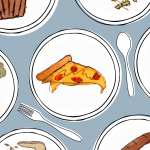Every year, the masses become enchanted with the holiday spirit. From bustling Christmas markets to Starbucks holiday beverages, most individuals can find something to get excited about during the season.
However, the festival I look forward to most is the “Festival of Lights” on Chanukah. One of my favorite aspects of the celebration is the mouthwatering food.
Fried Food
Chanukah is known for its fried delights, such as latkes and sufganiyot.
The miracle of Chanukah shares that the oil in the ancient menorah lit by the Maccabees lasted for eight days instead of lasting for one, as it was supposed to. Therefore, we eat foods soaked in oil to honor the miracle.
Healthy? Not so much. But, as we know, anything tastes good fried.

Latkes
Latkes are potato pancakes eaten around Eastern Europe.
You may have eaten Ukrainian Deruny or Polish Placki Ziemniaczane, both are variations of potato pancakes and are similar to latkes. Either way, latkes are classic and must be eaten on Chanukah. The way the crispy, golden brown potato shreds melt in my mouth brings me back to my childhood.
Gelt
The game of dreidel is a Chanukah classic. Traditionally, it is played with the prize of gelt, which are multi-sized chocolate coins. A dreidel is a spinning top, and there are four sides you can land on.
The Hebrew letter nun, which makes the “N” sound in English, gets you nothing — you are not allowed to take any gelt. The Hebrew letter shin, means you put one piece of gelt back into the communal pile. As we say, “shin, put one in.” If you land on the Hebrew letter he, you can take half of the gelt pile and with the letter gimel, you can take the entire pile. Although the game is traditionally played with gelt, many people use any kind of candy. My family typically uses a mix of leftover Halloween candy and gelt.
Sufganiyot
Sufganiyot is the Hebrew word for a jelly doughnut. These sweet treats are the perfect way to end any meal, but they are especially enjoyable for Chanukah. Similar to latkes, they commemorate the miracle of the ancient holiday. These oily pastries were not eaten at the time of Maccabees but originated from the Jews of North Africa.
The sweet, jam-filling did not come into play until the 16th century. Whether you pick up a sufganiyah from your local Dunkin’ or an authentic Jewish bakery, it is a great way to commemorate the sweetness of Chanukah.
Kugel
It’s rare to attend a Jewish holiday dinner without a plate of kugel in sight. There are numerous kinds of casserole dishes, each being made for different occasions. For my family, it is customary to eat noodle kugel on Rosh Hashanah, while having matzoh and potato kugel on Passover.
However, Chanukah is more of a free for all — any kind is welcome! Even though I normally do not eat this kind of kugel on Chanukah, I will always welcome my mother’s noodle kugel. There is hardly anything comparable to biting into the sweet cinnamon and custard noodle mixture.
Cookies
While these aren’t traditional Chanukah desserts, cookies are never a bad idea. In this case, I love making frosted sugar cookies in the shape of dreidels. Much of the excitement comes from the process of baking and decorating these cookies.
Sugar cookies are a major Christmas tradition, so if you are looking to intermix the holidays, these are a perfect, happy medium. Every year, my sister and I craft a Chanukah House — which is the same concept as a Gingerbread House, but with blue, yellow, and white decorations. This is another way you can integrate the two holidays.















Loved this article! Can’t wait to enjoy your dad’s latkes soon.